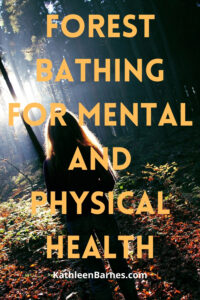Let’s take a little mental journey in preparation for a physical one:
It’s a bright summer morning.
The air is fresh.
You lace up your sneakers and embark on a mindful walk, through your neighborhood, a nearby park or, if you’re as lucky as I am, through the woods where you live.
At first, you notice the scent of earth and pine needles, maybe the rich smell of recently mowed grass. Bend over and smell a wildflower.
Then you wonder at the vigorous growth of ferns, the plants on the forest floor, the unfolding leaves of the oaks and maples.
Stand still for a moment and listen to the bird song. Maybe you can identify the “pretty-pretty-pretty” of a cardinal, the screech of a hawk, the shuffle of a squirrel searching for acorns or the gurgle of a nearby stream.
Feel the whisper of wind in your hair.
Reach out and touch the bark of a tree or the velvety smooth moss beneath your feet.
In your mind’s eye, walk on slowly and take in the sights. You might notice a brilliant orange mushroom just poking its head above the moss or even see a deer nibbling the bark of a tree or a hawk circling overhead.
Walk on and revel in the beauty and serenity of your surroundings.
Congratulations! You’ve just taken your first forest bath. I hope it’s the first of many. Now it’s time to get out there in the actual woods and repeat the experience.
What’s a forest bath, you ask?
The practice has its roots in an exercise first introduced in Japan in the 1980s. Shinrin-yoku (forest bathing) is meant to provide an “eco-antidote” to tech burnout (another Zoom meeting, anyone?) and to help people re-connect with our natural landscape and help protect it.
It’s not just airy-fairy stuff. Japanese researchers at the Nippon School of Medicine in Tokyo took blood from forest walkers and found some pretty impressive results: Just a two-hour forest bath resulted in significantly higher immune system function and even higher markers for the NK (natural killer) cells that help protect us against cancer.
You’ll notice in the exercise above that we engaged all five senses. That’s the key to walking meditation and especially for forest bathing. That’s really all you have to do. Anyone can take a forest bath. It doesn’t require any special skills or equipment. It’s quite likely never encounter another human.
Some say forest bathing is like a bridge between our senses and the natural world. It’s one most of us have lost. In fact, we are so far away from the natural world that the U.S. Environmental Protection Agency estimates that Americans spend 93% of our time indoors.
There is nothing specific to do during your forest bath. It’s not hiking or meditating or exercising. It’s just be-ing in the forest. You can wander. You can sit. You can lie down under a huge tree or jump into a hidden swimming hole. You can play with ants. That’s the beauty of it: There are no rules.
How long should your forest bath last? Ahh—you already know the answer to that. Your forest bath will last as long as you like.
Oh—did I forget to mention : Leave your cell phone behind.







